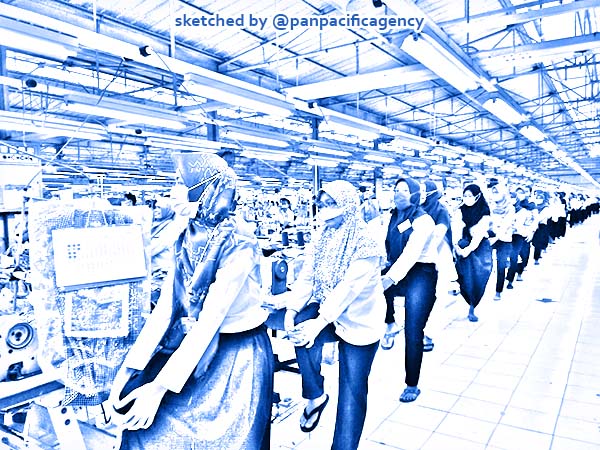World Bank downgrades Indonesia growth outlook, calls for reforms on grim global economy

Workers at a garment factory in Ungaran, Semarang, Central Java, carry out short daily exercise in between work on Thursday, Oct. 3.(Jakarta Post/Ardila Syakriah). Sketched by the Pan Pacific Agency.
JAKARTA, Oct 12, 2019, The Jakarta Post. The World Bank has cut Indonesia’s economic growth forecast for 2019, calling for reforms for East Asia and Pacific economies as they will be under long-term threat from increasing global trade tensions, reported The Jakarta Post.
Indonesia’s economy is projected to grow by 5 percent this year, the lowest annual economic growth since 2016, according to the October 2019 edition of the World Bank’s East Asia and Pacific Economic Update published on Thursday.
The 0.2-percentage-point cut from April’s forecast for Indonesia is in line with a broad-based deterioration in the economic growth outlook for the developing East Asia and Pacific region, excluding China, which is seen at 4.9 percent. The World Bank previously expected the region to grow 5.2 percent.
The lower growth projection reflects weakening global demand and heightened uncertainty around ongoing United States-China trade tensions that have led to a decline in exports and investment growth, testing the resilience of the region, according to the report, titled “Weathering Growth Risks”.
Therefore, countries in the region need to take an “active policy response” by using monetary and fiscal policy tools to stoke growth, said lead economist for East Asia and the Pacific, Andrew Mason.
“It would be important for countries to enact structural reforms to enhance competitiveness, improve business environments, attract investment and encourage innovations,” Mason said in a teleconference from Bangkok on Thursday. “These reforms are important for countries in East Asia and the Pacific even in good times, but they are particularly important this moment in an increasingly difficult international economic development.”
The International Monetary Fund (IMF) and Asian Development Bank (ADB) previously cut economic growth prospects for the world and for Asia, respectively. The World Trade Organization (WTO) slashed its global trade growth outlook significantly to 1.2 percent this year from a previous forecast of 2.6 percent.
“As growth slows, so does the rate of poverty reduction,” said Victoria Kwakwa, World Bank vice president for East Asia and the Pacific.
Seven million more people than the World Bank projected in April live with less than US$5.50 a day, rounding up to make almost a quarter of the population in the region living below the upper-middle-income poverty line.
For Indonesia, “despite recent progress in poverty reduction, one continuing challenge is to reduce inequality among regions in the country”, according to a section on Indonesia in the World Bank’s new report.
Prolonged trade tensions between China and the US, a fast-paced economic slowdown in China, European economies and the US, as well as Brexit uncertainty, could further weaken the global economy, as World Bank warns that downside risks to East Asia and Pacific’s growth prospects have intensified.
Although many countries expect to gain from the trade war-driven reconfiguration of the global trade landscape, the World Bank argued that the inflexibility of global value chains limits the upside for countries in the region in the near term. East Asia and Pacific countries will find it difficult to replace China’s role in global value chains because of inadequate infrastructure and small-scale production, according to the report.
The World Bank’s lead economist for Indonesia, Frederico Gil Sander, said rolling out reforms would be key in making Indonesia become more integrated with the global supply chain. One crucial policy recommendation is to ease import procedures for key capital goods that are needed for production processes.
“These days, global supply chains involve many countries importing and exporting,” said Sander. “So, this facility to import key inputs [goods] is actually key to attract export-oriented investments that create good jobs that pay better wages and also help in the long-term with the current account.”
On a regional level, Mason added that it was important for countries in East Asia and the Pacific to deepen regional integration frameworks such as ASEAN’s Regional Comprehensive Economic Partnership (RCEP) as a buffer against increased levels of uncertainty in the global environment.
Indonesia’s economic growth is seen picking up in 2020 and 2021 to 5.1 percent and 5.2 percent, respectively, after this year’s slowdown, World Bank estimates show.
The short-term pickup reflects a positive outlook in terms of accelerated growth in investments, which booked sluggish growth due to uncertainties surrounding the April presidential and legislative elections, Sander said.
Expansions in productivity and the labor force would also aid growth in the upcoming years on the back of the government’s focus on human capital development and investment.
“Though slower, investment growth is expected to remain robust, especially after the elections, with reduced political uncertainty and an improvement in business sentiments due to proposed reforms to attract FDI [foreign direct investment],” reads the World Bank report.
Investors are highly anticipating President Joko “Jokowi” Widodo’s upcoming Cabinet members, especially the new economic team, to push for structural reforms to jack up growth, said Center of Reform on Economic (CORE) Indonesia executive director Mohammad Faisal.
“If [the government] seriously conducts structural reforms and has a solid Cabinet, that would likely mean higher growth prospects,” Faisal said.
While policymakers have rolled out policies in their structural reform agenda to boost economic growth, from removing investment barriers to aggressive monetary policy easing, Faisal said businesses would likely want low-hanging fruit, with swift policy effects generating immediate impacts on the economy.